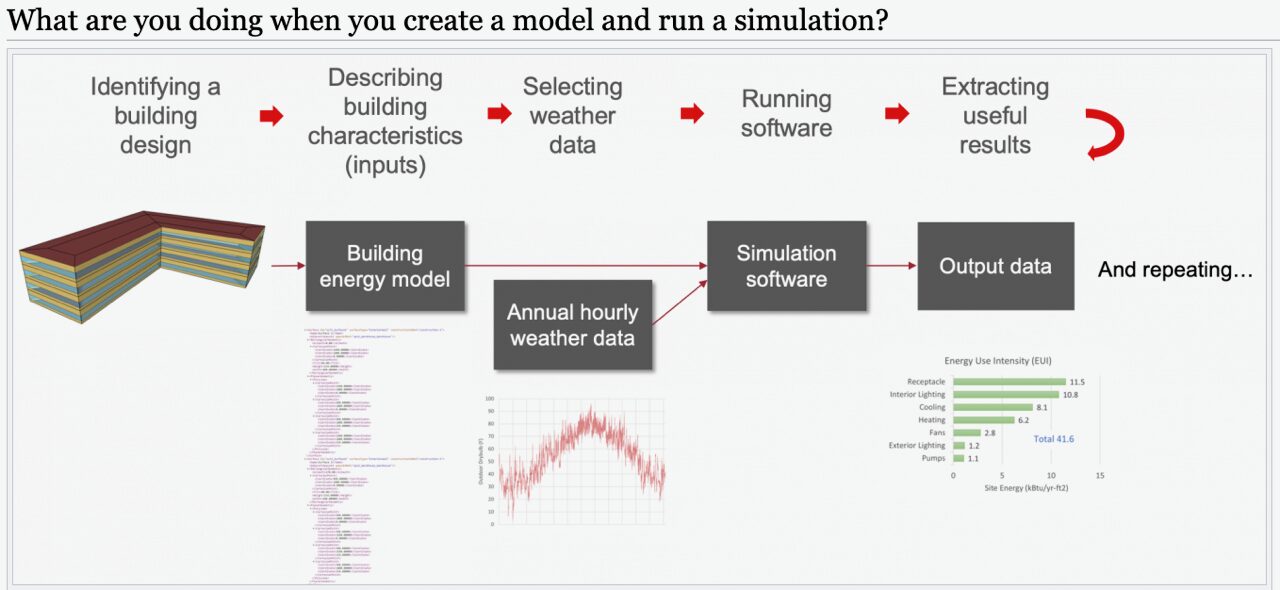How do you model buildings that use adaptive-thermal-comfort strategies?
– Adept Adapter
Dear Adept Adapter,
As modelers, we often follow the traditional approach of specifying (or selecting) static operational setpoints throughout the year (such as fixed 24°C / 75°F for cooling and 22°C / 72°F for heating in typical office buildings) in building simulations. There are often many valid reasons for us to proceed with this “static operational setpoints” approach, including lack of information about the building operation strategy or occupant preferences, alignment with the approaches used in reference models, or for simpler comparative assessment of the various design measures. While this approach may lead to acceptable results in many use cases (or applications), such as to demonstrate code compliance or to model fully air-conditioned buildings with centralized control systems, it may also lead to significant errors in many use cases, especially in buildings that are designed to operate with natural ventilation or mixed-mode ventilation strategies. In mixed-mode ventilation strategies, mechanical and natural ventilation systems work in tandem to achieve the desired environmental conditions inside the buildings. One possible resolution to overcome these errors is to define adaptive heating and cooling setpoints in the simulations.
In the last few decades, a lot of research has been conducted to better understand thermal comfort of building occupants. ASHRAE Standard 55-2020, titled, Thermal Environmental Conditions for Human Occupancy, specifies the combination of environmental (dry bulb temperature, mean radiant temperature, humidity, and air speed) and personal factors (clothing and activity) that will likely produce acceptable thermal conditions for the majority of the building occupants. The adaptive model is one of the methods specified in ASHRAE 55 Standard that defines acceptable thermal environmental conditions for occupant-controlled, naturally conditioned spaces.
The adaptive model recognizes that occupants actively interact with their environment, which leads to behavioral, physiological, and psychological thermal adaptation. It also recognizes that the thermal-comfort preferences of occupants vary based on contextual and historical factors as well as with the adaptation opportunity available to the occupants (such as availability of operable windows or pedestal fans).
In 2017, the ASHRAE 55 standard extended the applicability of the adaptive model to spaces where mechanical systems have been installed but are not currently in operation. This approach is also in alignment with the applicability specified in Standard EN15251. Further, recent research in tropical countries has demonstrated the applicability of the adaptive model in mixed-mode buildings.
In recent years, adaptive models have been incorporated into several building design and operation documents. Thus, it is important for us to determine suitable adaptive setpoints. Further, several studies have demonstrated that each degree (C) change in setpoint could lead to 6-10% reduction in energy use in an office building located in a hot climate[1] and may lead to even higher energy savings[2] when combined with additional mixed-mode control strategies. Hence, a “dynamic operational setpoints” approach is more appropriate while simulating buildings that use adaptive thermal comfort strategies. In such cases, the modeler will have to create a more detailed setpoint schedule for the simulation.
To this end, the following approach is taken:
- Mean daily outdoor temperature for each day is derived from the weather file (such as TMY3). This can be calculated as the simple arithmetic mean of 24-hour outdoor temperature.
- Derive the prevailing mean outdoor air temperature by averaging (simple arithmetic mean) the mean daily outdoor temperature of sequential days.[3]
- Once the prevailing mean outdoor air temperature is derived, the following graph (Figure 5.8 from ASHRAE 55-2020) can be used to calculate daily operative setpoint temperature for the simulation. Operative temperature is a simplified measure often used to estimate human thermal comfort. Its value is dependent on the air speed, dry-bulb and mean radiant temperature. It is calculated from the weighted average of mean radiant and dry-bulb temperatures inside buildings where the weight coefficient (0.5 to 0.7) is derived based on the average air speed. Mean radiant temperature is a measure used to estimate the impact of radiant heat exchange from the surfaces surrounding an occupant. It is calculated using weighted average of the mean surface temperatures surrounding the occupants where the weight coefficient of each surface is determined by the view factor from the occupant.
 Usually, the upper and lower 80% band values of operative temperature are used as cooling and heating setpoints, respectively, while modeling. If needed, this operative temperature could be converted to dry-bulb temperature based on the average air speed in the building. Where the average air speed inside the building is low (< 0.1 m/s) and the mean radiant and dry-bulb air temperatures are expected to be similar, modelers often assume dry-bulb temperature to be the same as operating temperature.
Usually, the upper and lower 80% band values of operative temperature are used as cooling and heating setpoints, respectively, while modeling. If needed, this operative temperature could be converted to dry-bulb temperature based on the average air speed in the building. Where the average air speed inside the building is low (< 0.1 m/s) and the mean radiant and dry-bulb air temperatures are expected to be similar, modelers often assume dry-bulb temperature to be the same as operating temperature. - Finally, these daily setpoints can be incorporated into a detailed schedule to simulate buildings that use adaptive thermal comfort strategies, and even receive credit for significant energy savings.
-
Ghawghawe K, Manu S, Shukla Y. Determining the Trade-offs between Thermal Comfort and Cooling Consumption in Indian Office Buildings. Presented at Passive Low Energy Architecture 2014 (PLEA 2014), Ahmedabad, India, 16–18 December 2014. ↩
-
Angelopoulos C, Cook M ,Spentzou E, Shukla Y. Energy saving potential of different setpoint control algorithms in mixed-mode buildings. Presented at Building Simulation and Optimization 2018 (BSO18), Cambridge, UK, 11–12 September 2018. ↩
-
The number of sequential days in the calculations should be more than 7 but fewer than 30 days. The selection of number of sequential days or weightage (to give more weightage to recent days) could be selected by the modeler if needed. ↩
 Yash Shukla, Ph.D
Yash Shukla, Ph.D
Principal Researcher and Centre Head, Centre for Advanced Research in Building Science and Energy (CARBSE), CEPT Research and Development Foundation (CRDF), CEPT University. Contact Yash Here






